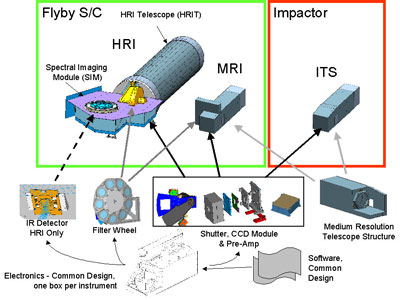High Resolution Instrument (HRI) |
Medium Resolution Instrument (MRI) |
Impactor Targeting Sensor (ITS) |
Built by Ball Aerospace & Technologies Corp., the Deep Impact instruments have two purposes. They guide the flyby spacecraft and impactor onto a collision course with the comet and they take the science data before, during, and after the impact. The instruments are designed so that they satisfy the following science requirements:
Pre-impact Imaging Requirements: |
Observe the comet and targeted impact site prior to impact, acquiring spatial and spectral data |
Ejecta Imaging Requirements: |
Observe the ejecta and track the movement of the ejecta curtain from crater to coma |
Crater Evolution Data Requirements: |
Observe the crater and surface evolution |
Pristine Crater Data Requirements: |
Observe the exposed pristine crater surface features via spectral imagers with increasing resolution |
Modular Design Requirements: |
Have opto-mechanically interchangeable focal plane modules |

The instrument platform holds the HRI and MRI on the flyby spacecraft.
The primary instruments on the flyby spacecraft are the High Resolution Instrument (HRI) and the Medium Resolution Instrument (MRI). The HRI, one of the largest space-based instruments built specifically for planetary science, is the main science camera for Deep Impact. It provides the highest resolution images via a combined visible camera, an infrared spectrometer, and a special imaging module. The HRI is optimally suited to observe the comet's nucleus. The MRI serves as the functional backup for the HRI, and is slightly better at navigation for the last 10 days of travel before impact due its wider field of view, which allows it to observe more stars around the comet. The difference between the two is the telescope, which sets the field of view (FOV) and the resolution of each.
The ITS on the impactor is nearly identical to the MRI as it uses the same type of telescope as the MRI as well as the same type of CCD that is in the MRI's Multi Spectral CCD Camera but differs only in that it lacks the filter wheel.

The three different instruments are built using common components.
The table below shows key optical parameters and performance of the Deep Impact instruments.
| Telescopes | HRI | MRI | ITS | |
| Diameter (cm) | 30 | 12 | 12 | |
| Focal Length (m) | 10.5 | 2.1 | 2.1 | |
| f/# | 35 | 17.5 | 17.5 | |
| Visible | HRI | MRI | ITS | |
| Format | 1024 x 1024 Split Frame Transfer CCD | |||
| Pixel Size (µm) | 21 | 21 | 21 | |
| IFOV (radians) | 2.0 x 10-6 | 10.0 x 10-6 | 10.0 x 10-6 | |
| FOV (radians) | 2.05 x 10-3 | 10.0 x 10-3 | 10.0 x 10-3 | |
| FOV (degrees) | 0.118 | 0.587 | 0.587 | |
| Projected scale at comet (m/pix) | 1.4 at 700 km | 7 at 700 km | 0.2 at 20 km | |
| IR | HRI | MRI | ITS | |
| Format | 512 x 256 HgCdTe FPA* |
N/A | N/A | |
| Pixel Size (µm) | 36 | |||
| Spatial | IFOV (radians) | 10.0 x 10-6 | ||
| FOV (radians) | 2.5 x 10-3 | |||
| FOV (degrees) | 0.29 | |||
| Spectral | IFOV (radians) | 10.0 x 10-6 | ||
| FOV (radians) (slit width) | 10 x 10-6 | |||
| Spectral Range | 1.05 - 4.8µm | |||
| Minimum λ/dλ | 216 | |||
Ball Aerospace & Technologies Corp. built Deep Impact's instruments between Fall 2001 and Spring 2003.
The Deep Impact CCDs were developed for the mission by Fairchild Imaging.
Music to my ears, uh, I mean - my instruments!
The science team won't just point an instrument at Comet Tempel 1 during impact and catch whatever data comes their way. There has to be a very specific sequence set to gather data and it is a little like a symphony. Read Dr. Lucy McFadden's comparison of the two here.











